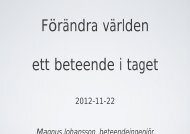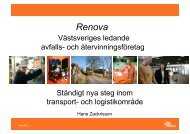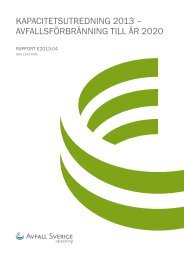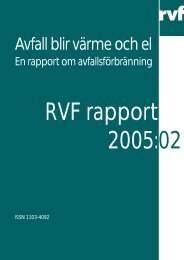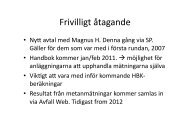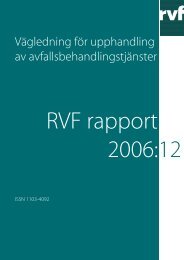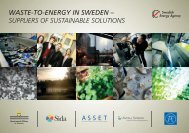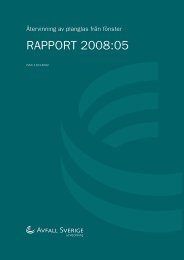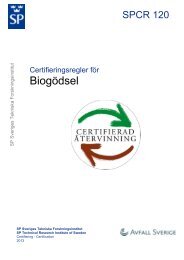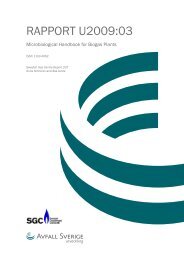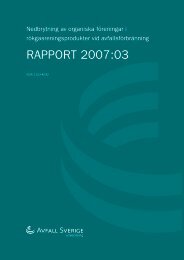2007:04 Hantering av förpackat livsmedelsavfall - Avfall Sverige
2007:04 Hantering av förpackat livsmedelsavfall - Avfall Sverige
2007:04 Hantering av förpackat livsmedelsavfall - Avfall Sverige
You also want an ePaper? Increase the reach of your titles
YUMPU automatically turns print PDFs into web optimized ePapers that Google loves.
DEWASTER ® - Sorting out the problems of mixed waste<br />
Subsequently, Aalborg Municipality continued with further trials based on mechanical pretreatment/pressing<br />
of OFMSW in 2001-2002 in preparation of an ambitious large scale source<br />
sorting/collection scheme known as “Bio21Aalborg”.<br />
The trials for the preparation of the Bio21Aalborg project proved that the DEWASTER® process was a<br />
viable solution to the problems with use of OFMSW in bio gas production. However, the Bio21Aalborg<br />
project for other reasons suffered political adversity, and ultimately the plans for the introduction of full<br />
scale source sorting of MSW in Aalborg were abandoned in December of 2002.<br />
Holbaek 2001-2003 – development of the DESIZER and FEEDER<br />
While waiting for the outcome of the trials and political decision-making process in respect to the<br />
Bio21Aalborg-project the development of the DEWASTER® technology continued in a project with the<br />
Danish waste company Noveren concerning the treatment of OFMSW at Noveren’s waste handling/composting<br />
facility in Holbaek, Denmark.<br />
During the project all the separated waste from October 2001 until February 2003, all together approximately<br />
3,000 tonnes, was processed. In the process the DEWASTER® press was developed to<br />
the design known today and further ancillary technical equipment was developed to make DE-<br />
WASTER® a full-fledged system for treatment of OFMSW.<br />
DESIZER<br />
During the project at Noveren it became clear that the sorting quality of OFMSW in Holbaek was insufficient<br />
to make the DEWASTER® press run without stops. Especially bones and small hard objects<br />
such as stones and metals in the OFMSW stocked up inside the DEWASTER® press causing extended<br />
wear on the press augers and press basket and occasional downtime. In response to these<br />
problems a unit with two rollers which does not allow hard objects exceeding a certain pre-defined size<br />
to pass through to the DEWASTER® press was devised. This unit, now known as the DESIZER and<br />
the use of metal separation equipment has decreased wear and stops on the press unit considerably.<br />
FEEDER<br />
During the operation at Noveren many different waste types were tested and it was discovered that<br />
certain type of waste, especially. “wet” waste could result in large drop in output capacity due to insufficient<br />
feeding of the DEWASTER® press. The initial solution to this problem was to force-feed the<br />
DEWASTER® press using a sliding vane positive displacement pump capable of delivering a discharge<br />
pressure of more than 30 bar.<br />
Use of this pump was successful in respect to many waste types, but proved less than optimal in respect<br />
to very wet waste types. Consequently a new double auger press with screens for discharging<br />
the wet waste was developed and installed at the Noveren facility in October 2002. The unit, now<br />
known as the FEEDER, significantly increased output capacity on wet waste.<br />
Hamburg 2002 - The DEWASTER® mobile test unit<br />
In November 2002 a mobile DEWASTER® plant in order to be able to test the DEWASTER® process<br />
on waste from potential customers was completed. The mobile plant was first used from December<br />
2002 until February 2003 to process CFW (Restaurant/large kitchen waste and super market waste)<br />
page 3 of 9



